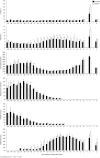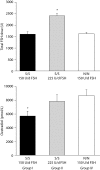Functional genetic polymorphisms and female reproductive disorders: Part I: Polycystic ovary syndrome and ovarian response
- PMID: 18603647
- PMCID: PMC2515090
- DOI: 10.1093/humupd/dmn024
Functional genetic polymorphisms and female reproductive disorders: Part I: Polycystic ovary syndrome and ovarian response
Abstract
Background: The identification of polymorphisms associated with a disease can help to elucidate its pathogenesis, and this knowledge can be used to improve prognosis for women with a particular disorder, such as polycystic ovary syndrome (PCOS). Since an altered response to ovarian stimulation is also a characteristic of the disease, further knowledge about its aetiology could help in defining the parameters that determine the response of an individual to ovarian stimulation.
Methods: PubMed and EMBASE databases were systematically searched for gene association studies published until the end of August 2007, using search criteria relevant to PCOS and ovarian response to stimulation. Data from additional papers identified through hand searches were also included; 139 publications were reviewed.
Results: Several genes involved in ovarian function and metabolism are associated with increased susceptibility to PCOS, but none is strong enough to correlate alone with susceptibility to the disease, or response to therapy. A single-nucleotide polymorphism in exon 10 of the FSH receptor (FSHR) gene, FSHR p.N680S, was consistently identified as having a significant association with ovarian response to FSH.
Conclusions: No consistent association between gene polymorphism and PCOS could be identified. The FSHR gene may play a significant role in the success of ovarian stimulation, and can be used as a marker to predict differences in FSHR function and ovarian response to FSH. Genotyping the FSHR p.N680S polymorphism may provide a means of identifying a population of poor responders before in vitro fertilization procedures are initiated.
Figures





References
-
- Abbott DH, Dumesic DA, Franks S. Developmental origin of polycystic ovary syndrome—a hypothesis. J Endocrinol. 2002;174:1–5. - PubMed
-
- Alcoser SY, Hara M, Bell GI, Ehrmann DA. Association of the (AU)AT-rich element polymorphism in PPP1R3 with hormonal and metabolic features of polycystic ovary syndrome. J Clin Endocrinol Metab. 2004;89:2973–2976. - PubMed
-
- Baba T, Endo T, Sata F, Honnma H, Kitajima Y, Hayashi T, Manase K, Kanaya M, Yamada H, Minakami H, et al. Polycystic ovary syndrome is associated with genetic polymorphism in the insulin signaling gene IRS-1 but not ENPP1 in a Japanese population. Life Sci. 2007;81:850–854. - PubMed
-
- Babu KA, Rao KL, Kanakavalli MK, Suryanarayana VV, Deenadayal M, Singh L. CYP1A1, GSTM1 and GSTT1 genetic polymorphism is associated with susceptibility to polycystic ovaries in South Indian women. Reprod Biomed Online. 2004;9:194–200. - PubMed
Publication types
MeSH terms
Substances
LinkOut - more resources
Full Text Sources
Other Literature Sources
Medical

